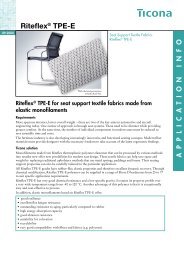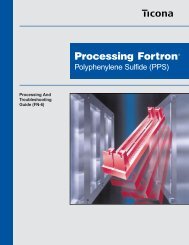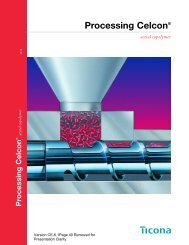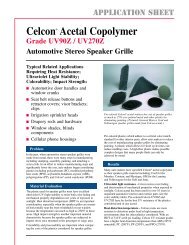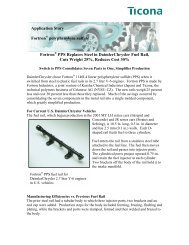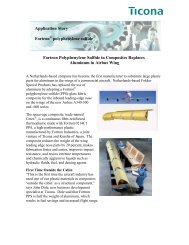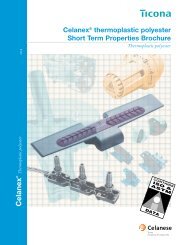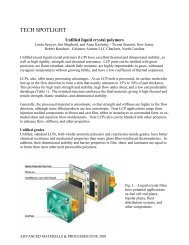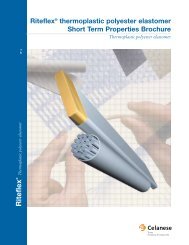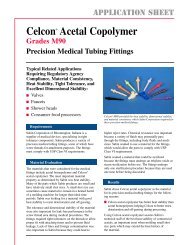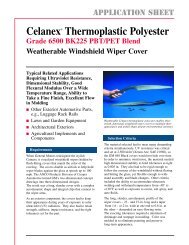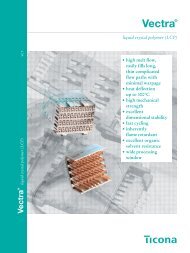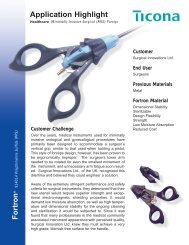Topas COC in Becton Dickinson Diagnostic Tube - Hi Polymers
Topas COC in Becton Dickinson Diagnostic Tube - Hi Polymers
Topas COC in Becton Dickinson Diagnostic Tube - Hi Polymers
Create successful ePaper yourself
Turn your PDF publications into a flip-book with our unique Google optimized e-Paper software.
Application Story<br />
<strong>Topas</strong> ® cyclic olef<strong>in</strong> copolymer<br />
<strong>Topas</strong> ® <strong>COC</strong> Replaces Glass <strong>in</strong> BD <strong>Tube</strong>rculosis <strong>Diagnostic</strong> <strong>Tube</strong>;<br />
<strong>COC</strong> Chosen Over Polycarbonate to Ga<strong>in</strong> Moisture Barrier<br />
<strong>Topas</strong> Cyclic Olef<strong>in</strong> Copolymer Reduces Risk of Biocontam<strong>in</strong>ation<br />
versus Glass; Extends Nutrient Media Life to One Year<br />
<strong>Topas</strong> ® cyclic olef<strong>in</strong> copolymer<br />
(<strong>COC</strong>) from Ticona has replaced<br />
glass <strong>in</strong> the diagnostic tubes BD<br />
(<strong>Becton</strong> Dick<strong>in</strong>son and Company)<br />
uses for tuberculosis test<strong>in</strong>g <strong>in</strong> its<br />
BACTEC MGIT 960 System.<br />
The switch to the far more shatter<br />
resistant <strong>COC</strong> reduces the risk of<br />
biocontam<strong>in</strong>ation. BD chose <strong>Topas</strong><br />
<strong>COC</strong> over polycarbonate for its high<br />
moisture barrier, so the nutrient<br />
media <strong>in</strong> the tube has a shelf life of at least 12<br />
months.<br />
In test<strong>in</strong>g for Mycobacterium tuberculosis<br />
(TB), the BACTEC MGIT 960 System<br />
<strong>in</strong>cubates a sample and then detects the growth<br />
of organisms with a sensor that measures<br />
fluorescence at 365 nm. This high-capacity<br />
system can accommodate up to 8,000<br />
specimens a year. It also cultures TB bacteria<br />
<strong>in</strong> 1 to 2 weeks <strong>in</strong>stead of the 3 to 4 weeks<br />
needed with traditional methods.<br />
“<strong>Topas</strong> <strong>COC</strong> elim<strong>in</strong>ated the need to enclose<br />
the 16-by-100-mm tubes <strong>in</strong> costly barrier<br />
packag<strong>in</strong>g,” says Carole Jefferson, market<strong>in</strong>g<br />
manager at BD. “Its low permeability to water<br />
vapor (about 0.02 g-mm/m 2 day) means that<br />
the media loses little water over the long-term.<br />
The <strong>COC</strong> gave us many other important<br />
benefits. For <strong>in</strong>stance, it is transparent at the<br />
wavelength measured, does not react with the<br />
growth media, has almost no extractables and<br />
withstands steam sterilization <strong>in</strong> an autoclave.”
The <strong>in</strong>jection blow molded tube has a uniform wall with a m<strong>in</strong>imum thickness of 0.03 <strong>in</strong>.<br />
Blow mold<strong>in</strong>g provides better dimensional control for seal<strong>in</strong>g than was possible with glass.<br />
The seal<strong>in</strong>g surface <strong>in</strong> the plastic tube is controlled to with<strong>in</strong> 0.005 <strong>in</strong>. as opposed to 0.01 <strong>in</strong>.<br />
with glass.<br />
The tube is molded at Wheaton Plastics <strong>in</strong> Millville, NJ. Earl Sk<strong>in</strong>ner, project manager at<br />
Wheaton, says, “the <strong>COC</strong> processes much like polypropylene. It blow molds easily and has<br />
a broad process<strong>in</strong>g range. It also flows well, is dimensionally stable and has good<br />
repeatability.”<br />
The automated BACTEC MGIT 960 system is a high-productivity unit typically used <strong>in</strong><br />
hospitals, large reference labs and public health labs. The round-bottomed <strong>COC</strong> tubes used<br />
<strong>in</strong> the system conta<strong>in</strong> an aqueous, Middlebrook 7H9-based nutrient media to support<br />
bacterial growth.<br />
<strong>Topas</strong> <strong>COC</strong> is a family of amorphous eng<strong>in</strong>eer<strong>in</strong>g plastics that offers high clarity,<br />
transparency, stiffness, strength, low moisture absorption and excellent dimensional<br />
stability. The <strong>Topas</strong> <strong>COC</strong> res<strong>in</strong> used <strong>in</strong> the BACTEC MGIT 960 system meets U.S.P. Class<br />
VI requirements and has received U.S. Food and Drug Adm<strong>in</strong>istration (FDA) Drug and<br />
Device Master File and numbers DMF# 12132 and MAF# 1043, respectively. Beyond<br />
medical and laboratory applications, <strong>Topas</strong> <strong>COC</strong>s can be used <strong>in</strong> a variety of applications,<br />
such as pharmaceutical blister packag<strong>in</strong>g, food packag<strong>in</strong>g, precision molded optics and<br />
pr<strong>in</strong>ter toner b<strong>in</strong>der res<strong>in</strong>s.<br />
Technical Information: 1-800-833-4882 Customer Services: 1-800-526-4960<br />
NOTICE TO USERS: To the best of our knowledge, the <strong>in</strong>formation conta<strong>in</strong>ed <strong>in</strong> this publication is accurate; however, we do not<br />
assume any liability whatsoever for the accuracy and completeness of such <strong>in</strong>formation. The <strong>in</strong>formation conta<strong>in</strong>ed <strong>in</strong> this publication<br />
should not be construed as a promise or guarantee of specific properties of our products.<br />
Any values shown are based on test<strong>in</strong>g of laboratory test specimens and represent data that fall with<strong>in</strong> the standard range of properties for<br />
natural material. These values alone do not represent a sufficient basis for any part design. Colorants or other additives may cause<br />
significant variations <strong>in</strong> data values.<br />
Properties of molded parts can be <strong>in</strong>fluenced by a wide variety of factors <strong>in</strong>clud<strong>in</strong>g, but not limited to, material selection, additives, part<br />
design, process<strong>in</strong>g conditions and environmental exposure. Any determ<strong>in</strong>ation of the suitability of a particular material and part design<br />
for any use contemplated by the users and the manner of such use is the sole responsibility of the users, who must assure themselves that<br />
the material as subsequently processed meets the needs of their particular product or use.<br />
It is the sole responsibility of the users to <strong>in</strong>vestigate whether any exist<strong>in</strong>g patents are <strong>in</strong>fr<strong>in</strong>ged by the use of the materials mentioned <strong>in</strong><br />
this publication.<br />
Please call the numbers listed for additional technical <strong>in</strong>formation. Call Customer Services for the appropriate Materials Safety Data<br />
Sheets (MSDS) before attempt<strong>in</strong>g to process our products.<br />
The products mentioned here<strong>in</strong> are not <strong>in</strong>tended for use <strong>in</strong> medical or dental implants.<br />
Ticona<br />
90 Morris Avenue<br />
Summit, NJ 07901<br />
www.ticona.com 01-331/Elec/0601




